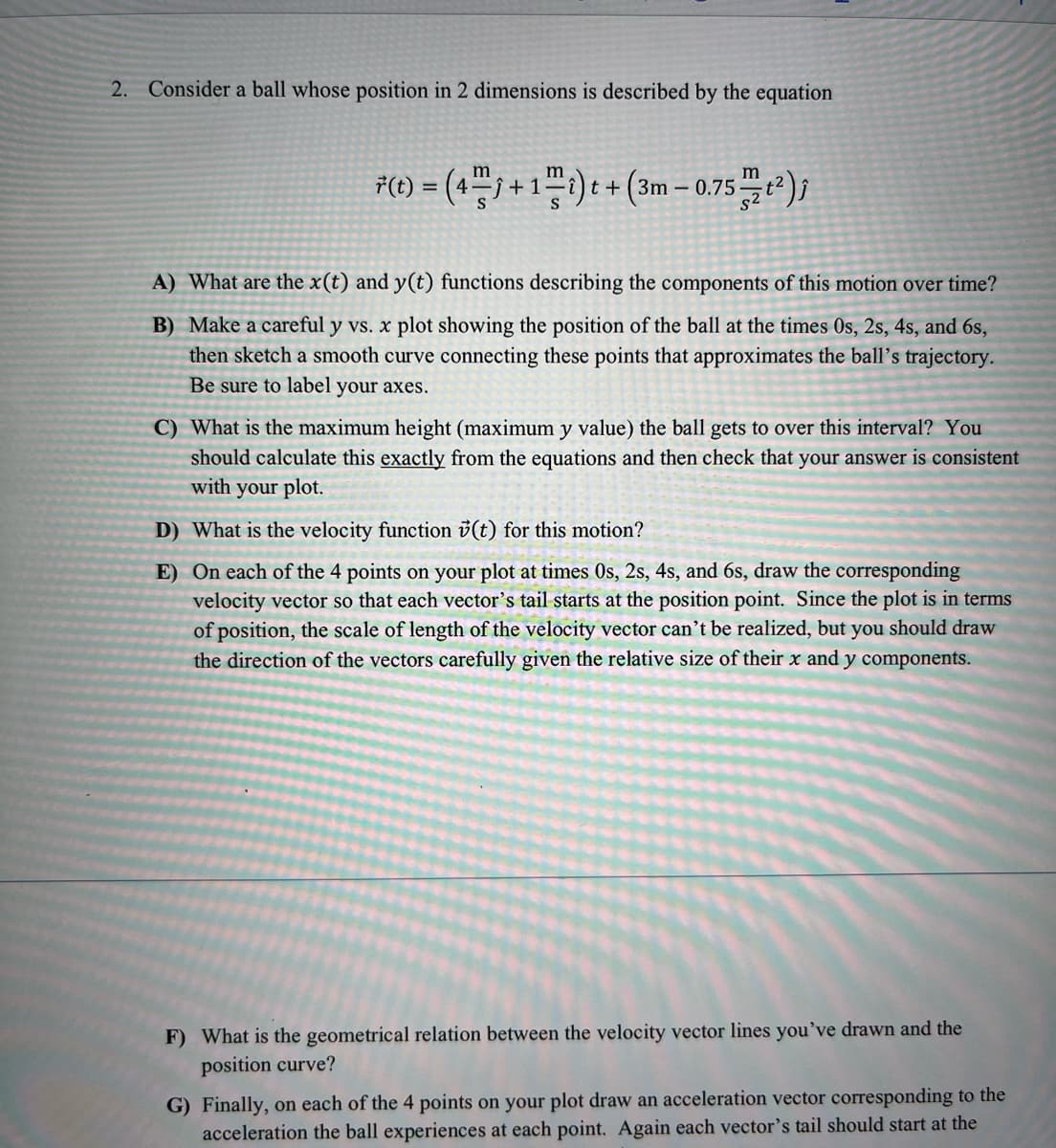Consider a ball whose position in 2 dimensions is described by the equation #(1) = (4"j + 11) t + (3m – 0.75); t +(3m s2 A) What are the x(t) and y(t) functions describing the components of this motion over time? B) Make a careful y vs. x plot showing the position of the ball at the times Os, 2s, 4s, and 6s, then sketch a smooth curve connecting these points that approximates the ball’s trajectory. Be sure to label your axes. C) What is the maximum height (maximum y value) the ball gets to over this interval? You should calculate this exactly from the equations and then check that your answer is consiste with your plot. D) What is the velocity function v(t) for this motion? E) On each of the 4 points on your plot at times 0s, 2s, 4s, and 6s, draw the corresponding velocity vector so that each vector's tail starts at the position point. Since the plot is in term of position, the scale of length of the velocity vector can't be realized, but you should draw the direction of the vectors carefully given the relative size of their x and y components.
Consider a ball whose position in 2 dimensions is described by the equation #(1) = (4"j + 11) t + (3m – 0.75); t +(3m s2 A) What are the x(t) and y(t) functions describing the components of this motion over time? B) Make a careful y vs. x plot showing the position of the ball at the times Os, 2s, 4s, and 6s, then sketch a smooth curve connecting these points that approximates the ball’s trajectory. Be sure to label your axes. C) What is the maximum height (maximum y value) the ball gets to over this interval? You should calculate this exactly from the equations and then check that your answer is consiste with your plot. D) What is the velocity function v(t) for this motion? E) On each of the 4 points on your plot at times 0s, 2s, 4s, and 6s, draw the corresponding velocity vector so that each vector's tail starts at the position point. Since the plot is in term of position, the scale of length of the velocity vector can't be realized, but you should draw the direction of the vectors carefully given the relative size of their x and y components.
College Physics
1st Edition
ISBN:9781938168000
Author:Paul Peter Urone, Roger Hinrichs
Publisher:Paul Peter Urone, Roger Hinrichs
Chapter3: Two-dimensional Kinematics
Section: Chapter Questions
Problem 64PE: (a) Use the distance and velocity data in Figure 3.64 to find the rate of expansion as a function of...
Related questions
Question

Transcribed Image Text:2. Consider a ball whose position
2 dimensions is described by the equation
#(t) = (4" +1:) t + (3m – 0.75);
%D
A) What are the x(t) and y(t) functions describing the components of this motion over time?
B) Make a careful y vs. x plot showing the position of the ball at the times Os, 2s, 4s, and 6s,
then sketch a smooth curve connecting these points that approximates the ball's trajectory.
Be sure to label your axes.
C) What is the maximum height (maximum y value) the ball gets to over this interval? You
should calculate this exactly from the equations and then check that your answer is consistent
with your plot.
D) What is the velocity function v(t) for this motion?
E) On each of the 4 points on your plot at times Os, 2s, 4s, and 6s, draw the corresponding
velocity vector so that each vector's tail starts at the position point. Since the plot is in terms
of position, the scale of length of the velocity vector can’t be realized, but you should draw
the direction of the vectors carefully given the relative size of their x and y components.
F) What is the geometrical relation between the velocity vector lines you've drawn and the
position curve?
G) Finally, on each of the 4 points on your plot draw an acceleration vector corresponding to the
acceleration the ball experiences at each point. Again each vector's tail should start at the
Expert Solution
Step 1
Since you have posted a question with multiple subparts, we will solve the first three only as per Bartleby Q&A guideline. Please resubmit the question for the solutions of next subparts.
Given that:
Step by step
Solved in 4 steps with 1 images

Knowledge Booster
Learn more about
Need a deep-dive on the concept behind this application? Look no further. Learn more about this topic, physics and related others by exploring similar questions and additional content below.Recommended textbooks for you

College Physics
Physics
ISBN:
9781938168000
Author:
Paul Peter Urone, Roger Hinrichs
Publisher:
OpenStax College

Physics for Scientists and Engineers: Foundations…
Physics
ISBN:
9781133939146
Author:
Katz, Debora M.
Publisher:
Cengage Learning

College Physics
Physics
ISBN:
9781938168000
Author:
Paul Peter Urone, Roger Hinrichs
Publisher:
OpenStax College

Physics for Scientists and Engineers: Foundations…
Physics
ISBN:
9781133939146
Author:
Katz, Debora M.
Publisher:
Cengage Learning